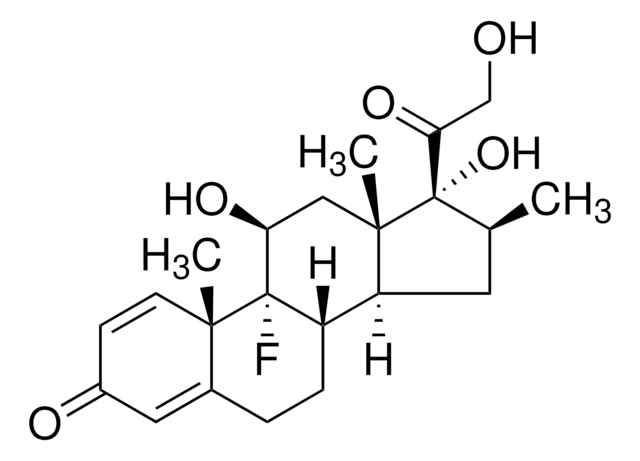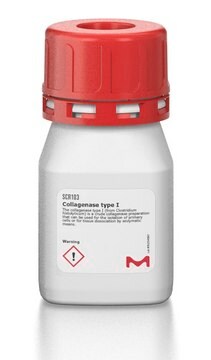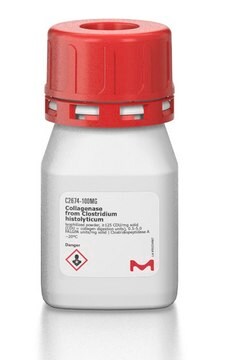C5138
Collagenase from Clostridium histolyticum
suitable for release of physiologically active rat hepatocytes, Type IV, 0.5-5.0 FALGPA units/mg solid, ≥125 CDU/mg solid
Synonym(s):
Clostridiopeptidase A
About This Item
Recommended Products
biological source
Clostridium histolyticum
Quality Level
form
powder
specific activity
≥125 CDU/mg solid
0.5-5.0 FALGPA units/mg solid
mol wt
68-130 kDa
technique(s)
cell culture | mammalian: suitable
single cell analysis: suitable
solubility
TESCA buffer (50 mM TES, 0.36 mM Calcium chloride, pH 7.4): soluble 0.05-0.1 mg/mL at 37 °C
suitability
suitable for release of physiologically active rat hepatocytes
application(s)
diagnostic assay manufacturing
shipped in
wet ice
storage temp.
−20°C
Looking for similar products? Visit Product Comparison Guide
Application
- in the preparation of collagenase solution for the digestion of tumor tissues
- as a supplement in phosphate-buffered saline for the digestion of extirpated mesenteric fat tissue
- as a supplement in Roswell Park Memorial Institute-1640 medium (RPMI-1640) for the digestion of colon segments
- for the digestion of endometrium tissues
- in the preparation of enzyme A and enzyme B for the digestion of decapsulated testes
Suitable for use in preparation of single cell suspension for sequencing.
Biochem/physiol Actions
Caution
Unit Definition
Preparation Note
This product also contains clostripain, neutral protease and tryptic activities.
also commonly purchased with this product
substrate
Signal Word
Danger
Hazard Statements
Precautionary Statements
Hazard Classifications
Eye Irrit. 2 - Resp. Sens. 1 - Skin Irrit. 2 - STOT SE 3
Target Organs
Respiratory system
Storage Class Code
11 - Combustible Solids
WGK
WGK 1
Flash Point(F)
Not applicable
Flash Point(C)
Not applicable
Personal Protective Equipment
Certificates of Analysis (COA)
Search for Certificates of Analysis (COA) by entering the products Lot/Batch Number. Lot and Batch Numbers can be found on a product’s label following the words ‘Lot’ or ‘Batch’.
Already Own This Product?
Find documentation for the products that you have recently purchased in the Document Library.
Customers Also Viewed
Articles
Organoid culture products to generate tissue and stem cell derived 3D brain, intestinal, gut, lung and cancer tumor organoid models.
Protocols
This procedure may be used for Collagenase products.
Our team of scientists has experience in all areas of research including Life Science, Material Science, Chemical Synthesis, Chromatography, Analytical and many others.
Contact Technical Service












